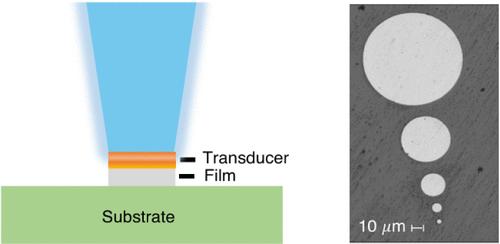当前位置:
X-MOL 学术
›
ACS Appl. Mater. Interfaces
›
论文详情
Our official English website, www.x-mol.net, welcomes your
feedback! (Note: you will need to create a separate account there.)
Measurements of Thermal Resistance Across Buried Interfaces with Frequency-Domain Thermoreflectance and Microscale Confinement
ACS Applied Materials & Interfaces ( IF 8.3 ) Pub Date : 2024-07-24 , DOI: 10.1021/acsami.4c05258 Ronald J Warzoha 1 , Adam A Wilson 2 , Brian F Donovan 3 , Andy Clark 4 , Xuemei Cheng 4 , Lu An 5 , Gang Feng 5
ACS Applied Materials & Interfaces ( IF 8.3 ) Pub Date : 2024-07-24 , DOI: 10.1021/acsami.4c05258 Ronald J Warzoha 1 , Adam A Wilson 2 , Brian F Donovan 3 , Andy Clark 4 , Xuemei Cheng 4 , Lu An 5 , Gang Feng 5
Affiliation

|
Confined geometries are used to increase measurement sensitivity to thermal boundary resistance at buried SiO2 interfaces with frequency-domain thermoreflectance (FDTR). We show that radial confinement of the transducer film and additional underlying material layers prevents heat from spreading and increases the thermal penetration depth of the thermal wave. Parametric analyses are performed with finite element methods and used to examine the extent to which the thermal penetration depth increases as a function of a material’s effective thermal resistance and the degree of material confinement relative to the pump beam diameter. To our surprise, results suggest that the measurement technique is not always the most sensitive to the largest thermal resistor in a multilayer material. We also find that increasing the degree to which a material is confined improves measurement sensitivity to the thermal resistance across material interfaces that are buried 10s of μm to mm below the surface. These results are used to design experimental measurements of etched, 200 nm thick SiO2 films deposited on Al2O3 substrates, and offer an opportunity for thermal scientists and engineers to characterize the thermal resistance across a broader range of material interfaces within electronic device architectures that have historically been difficult to access via experiment.
中文翻译:

利用频域热反射和微尺度约束测量埋地界面的热阻
受限几何形状用于通过频域热反射 (FDTR) 提高掩埋 SiO 2界面处热边界电阻的测量灵敏度。我们表明,换能器薄膜和附加底层材料层的径向限制可防止热量扩散并增加热波的热穿透深度。参数分析采用有限元方法进行,用于检查热穿透深度随材料的有效热阻和材料相对于泵浦光束直径的限制程度而增加的程度。令我们惊讶的是,结果表明测量技术并不总是对多层材料中最大的热阻最敏感。我们还发现,增加材料的限制程度可以提高对埋藏在表面以下 10 微米至毫米的材料界面热阻的测量灵敏度。这些结果用于设计沉积在 Al 2 O 3基板上的蚀刻 200 nm 厚 SiO 2薄膜的实验测量,并为热科学家和工程师提供了表征电子设备架构中更广泛材料界面的热阻的机会历史上很难通过实验获得。
更新日期:2024-07-24
中文翻译:

利用频域热反射和微尺度约束测量埋地界面的热阻
受限几何形状用于通过频域热反射 (FDTR) 提高掩埋 SiO 2界面处热边界电阻的测量灵敏度。我们表明,换能器薄膜和附加底层材料层的径向限制可防止热量扩散并增加热波的热穿透深度。参数分析采用有限元方法进行,用于检查热穿透深度随材料的有效热阻和材料相对于泵浦光束直径的限制程度而增加的程度。令我们惊讶的是,结果表明测量技术并不总是对多层材料中最大的热阻最敏感。我们还发现,增加材料的限制程度可以提高对埋藏在表面以下 10 微米至毫米的材料界面热阻的测量灵敏度。这些结果用于设计沉积在 Al 2 O 3基板上的蚀刻 200 nm 厚 SiO 2薄膜的实验测量,并为热科学家和工程师提供了表征电子设备架构中更广泛材料界面的热阻的机会历史上很难通过实验获得。











































 京公网安备 11010802027423号
京公网安备 11010802027423号